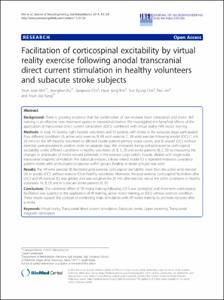KUMEL Repository
1. Journal Papers (연구논문)
1. School of Medicine (의과대학)
Dept. of Biomedical Engineering (의용공학과)
Facilitation of corticospinal excitability by virtual reality exercise following anodal transcranial direct current stimulation in healthy volunteers and subacute stroke subjects
- Affiliated Author(s)
- 구정훈
- Alternative Author(s)
- Ku, Jeong Hun
- Journal Title
- Journal of NeuroEngineering and Rehabilitation
- ISSN
- 1743-0003
- Issued Date
- 2014
- Keyword
- Virtual reality; Transcranial direct current stimulation; Subacute stroke; Upper extremity; Transcranial magnetic stimulation
- Abstract
- Background: There is growing evidence that the combination of non-invasive brain stimulation and motor skill
training is an effective new treatment option in neurorehabilitation. We investigated the beneficial effects of the
application of transcranial direct current stimulation (tDCS) combined with virtual reality (VR) motor training.
Methods: In total, 15 healthy, right-handed volunteers and 15 patients with stroke in the subacute stage participated.
Four different conditions (A: active wrist exercise, B: VR wrist exercise, C: VR wrist exercise following anodal tDCS (1 mV,
20 min) on the left (healthy volunteer) or affected (stroke patient) primary motor cortex, and D: anodal tDCS without
exercise) were provided in random order on separate days. We compared during and post-exercise corticospinal
excitability under different conditions in healthy volunteers (A, B, C, D) and stroke patients (B, C, D) by measuring the
changes in amplitudes of motor evoked potentials in the extensor carpi radialis muscle, elicited with single-pulse
transcranial magnetic stimulation. For statistical analyses, a linear mixed model for a repeated-measures covariance
pattern model with unstructured covariance within groups (healthy or stroke groups) was used.
Results: The VR wrist exercise (B) facilitated post-exercise corticospinal excitability more than the active wrist exercise
(A) or anodal tDCS without exercise (D) in healthy volunteers. Moreover, the post-exercise corticospinal facilitation after
tDCS and VR exercise (C) was greater and was sustained for 20 min after exercise versus the other conditions in healthy
volunteers (A, B, D) and in subacute stroke patients (B, D).
Conclusions: The combined effect of VR motor training following tDCS was synergistic and short-term corticospinal
facilitation was superior to the application of VR training, active motor training, or tDCS without exercise condition.
These results support the concept of combining brain stimulation with VR motor training to promote recovery after
a stroke.
- Department
- Dept. of Biomedical Engineering (의용공학과)
- Publisher
- School of Medicine
- Citation
- Yeun Joon Kim et al. (2014). Facilitation of corticospinal excitability by virtual reality exercise following anodal transcranial direct current stimulation in healthy volunteers and subacute stroke subjects. Journal of NeuroEngineering and Rehabilitation, 11(1), 124–124. doi: 10.1186/1743-0003-11-124
- Type
- Article
- ISSN
- 1743-0003
- Appears in Collections:
- 1. School of Medicine (의과대학) > Dept. of Biomedical Engineering (의용공학과)
- 파일 목록
-
-
Download
 oak-aaa-3035.pdf
기타 데이터 / 1.1 MB / Adobe PDF
oak-aaa-3035.pdf
기타 데이터 / 1.1 MB / Adobe PDF
-
Items in Repository are protected by copyright, with all rights reserved, unless otherwise indicated.